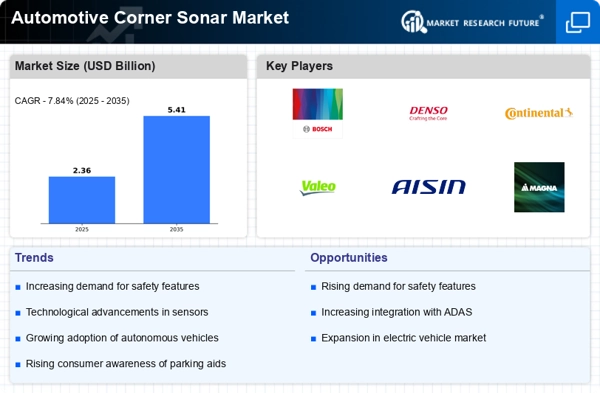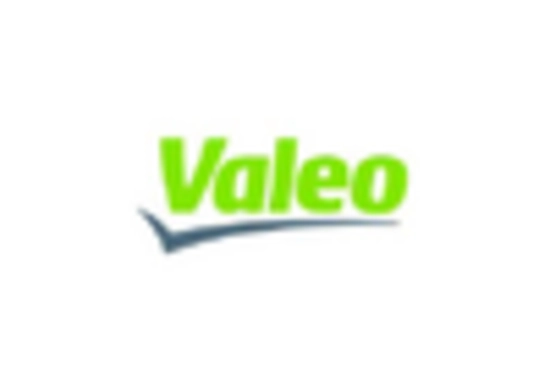Regulatory Standards and Compliance
The Automotive Corner Sonar Market is also influenced by stringent regulatory standards aimed at improving vehicle safety. Governments worldwide are implementing regulations that mandate the inclusion of advanced safety features in new vehicles. For instance, regulations requiring collision avoidance systems are becoming more prevalent, pushing manufacturers to adopt corner sonar technology. Compliance with these regulations not only enhances vehicle safety but also provides manufacturers with a competitive edge in the market. As a result, the market is expected to witness a steady increase in demand for corner sonar systems, as manufacturers seek to align their products with regulatory requirements and consumer expectations.
Rising Adoption of Electric Vehicles
The shift towards electric vehicles (EVs) is another significant driver for the Automotive Corner Sonar Market. As the automotive industry transitions to more sustainable transportation solutions, the integration of advanced safety features, including corner sonar systems, becomes increasingly important. EV manufacturers are recognizing the necessity of incorporating these technologies to enhance safety and assist drivers in navigating urban environments. Market analysis suggests that the EV segment is expected to grow at a rate of 15% annually, further propelling the demand for corner sonar systems. This trend indicates a potential for innovation and collaboration between traditional automotive manufacturers and new entrants in the EV market.
Growing Consumer Demand for Safety Features
Consumer preferences are shifting towards vehicles equipped with advanced safety features, significantly impacting the Automotive Corner Sonar Market. As awareness of road safety increases, consumers are more inclined to purchase vehicles that offer enhanced safety technologies, including corner sonar systems. This trend is reflected in market data, indicating that nearly 60% of new vehicle buyers prioritize safety features in their purchasing decisions. Consequently, automotive manufacturers are investing heavily in integrating corner sonar technology into their models to meet consumer expectations. This growing demand is likely to drive market expansion, as manufacturers strive to differentiate their offerings in a competitive landscape.
Increased Investment in Research and Development
Investment in research and development (R&D) within the Automotive Corner Sonar Market is on the rise, as companies strive to innovate and improve their product offerings. This investment is crucial for developing next-generation sonar technologies that can provide enhanced performance and reliability. Companies are focusing on creating systems that can operate effectively in various environmental conditions, thereby expanding their applicability. The market is witnessing a trend where manufacturers allocate a significant portion of their budgets to R&D, with estimates suggesting that R&D spending in the automotive sector could reach $100 billion by 2026. This focus on innovation is likely to drive the growth of the corner sonar market, as new technologies emerge to meet evolving consumer and regulatory demands.
Technological Innovations in Automotive Corner Sonar
The Automotive Corner Sonar Market is experiencing a surge in technological innovations, particularly in sensor technology. Advanced sonar systems are being developed to enhance vehicle safety and parking assistance. These systems utilize high-frequency sound waves to detect obstacles, providing real-time feedback to drivers. The integration of artificial intelligence and machine learning algorithms into these systems is expected to improve their accuracy and reliability. As a result, the market is projected to grow at a compound annual growth rate of approximately 8% over the next five years. This growth is driven by the increasing demand for advanced driver-assistance systems (ADAS) and the rising adoption of autonomous vehicles, which rely heavily on precise sensing technologies.

















Leave a Comment